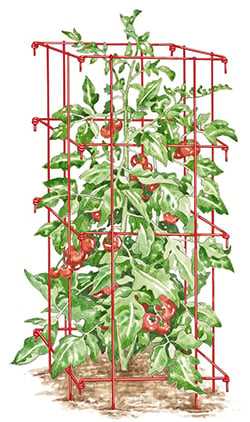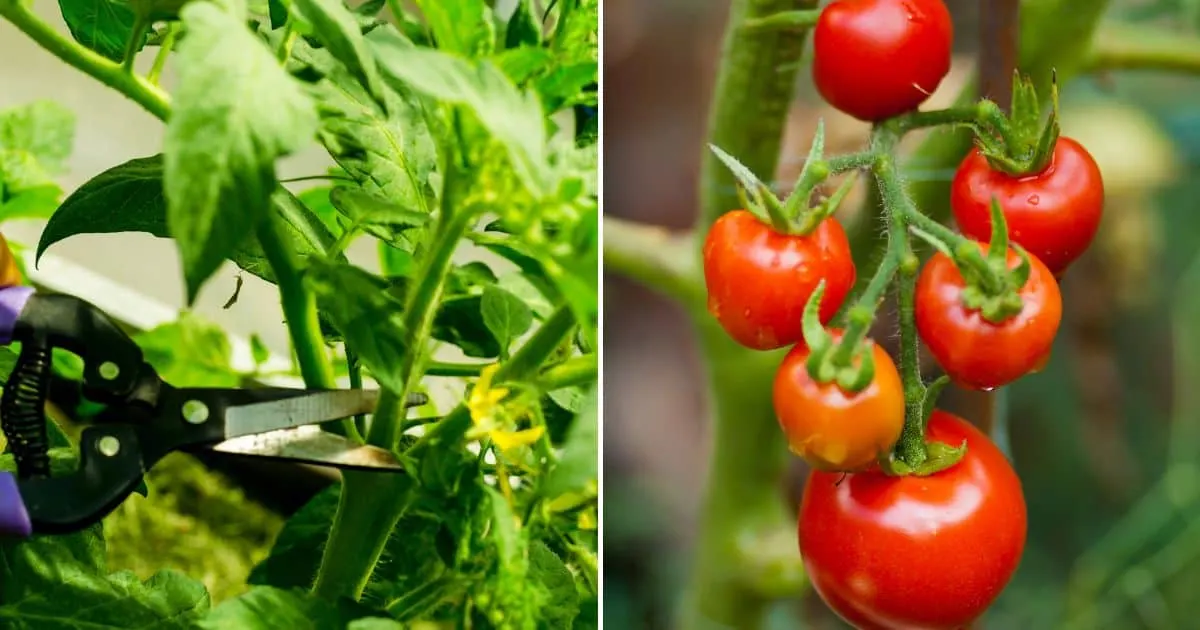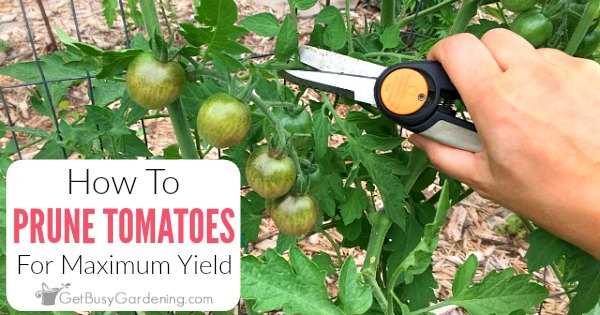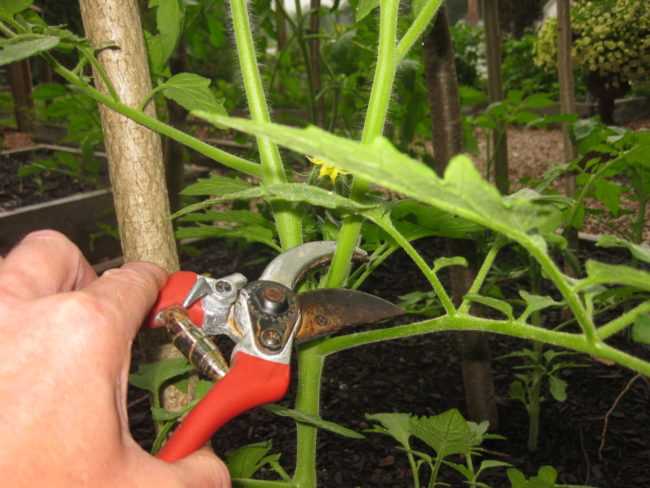- The Importance of Pruning
- When to Start Pruning
- Tools for Effective Pruning
- Pruning Techniques for Stepchildren
- 1. Identify the Stepchildren
- 2. Determine the Size to Prune
- 3. Use Clean and Sharp Tools
- 4. Remove Stepchildren Strategically
- 5. Prune Regularly
- 6. Consider Staking or Trellising
- 7. Monitor and Adjust
- Removing Suckers and Extra Foliage
- Why Remove Suckers?
- How to Remove Suckers
- Removing Extra Foliage
- Pruning for Optimal Fruit Production
- 1. Remove Suckers
- 2. Prune Lower Leaves
- 3. Thin Out Overcrowded Branches
- 4. Stake and Train Plants
- 5. Prune Regularly
- 6. Use Clean and Sharp Pruning Tools
- Common Mistakes to Avoid
- Pruning Stepchildren for Healthy Plants
- Benefits of Pruning Stepchildren
- Pruning Techniques for Stepchildren
- Conclusion
- “Question-Answer”
- Why is it important to prune stepchildren of tomatoes?
- When is the best time to prune stepchildren of tomatoes?
- What tools are needed for pruning stepchildren of tomatoes?
- How should I prune stepchildren of tomatoes?
- What are the benefits of pruning stepchildren of tomatoes?
- “Video” How to Prune Tomatoes for Earlier Harvests, Higher Yields & Healthier Plants
Tomatoes are one of the most popular and widely grown vegetables in home gardens. However, many gardeners struggle to achieve optimal yields and fruit quality due to inefficiencies in their tomato plants’ growth. One technique that can significantly improve the health and productivity of tomato plants is pruning. While the main stem and branches of the plant are typically pruned, the “stepchildren” or suckers are often overlooked. Pruning the stepchildren, also known as lateral shoots, can help redirect the plant’s energy towards fruit production and improve air circulation, thereby reducing the risk of disease.
Stepchildren, or suckers, are the small, leafy, vegetative growths that emerge from the leaf axils of tomato plants. If left unchecked, these stepchildren can grow into additional branches, creating a dense and bushy plant. While this may seem beneficial, it can actually hinder the overall health and productivity of the plant. Pruning the stepchildren allows the plant to focus its energy on developing larger, more productive fruit by reducing competition for resources.
When it comes to pruning stepchildren, timing and technique are crucial. It is recommended to perform this pruning task regularly throughout the growing season, beginning when the plants are young and continuing until they reach their maximum height. Ideally, stepchildren should be pruned when they are small and easy to remove, typically around 4-6 inches in length. A sharp pair of pruners or scissors should be used to make clean and precise cuts, ensuring minimal damage to the plant.
Tip: To identify stepchildren, look for the small shoots growing in the leaf axils, which are the junctions between the stem and the base of each leaf. Stepchildren can be distinguished from the main stem by their smaller size and lack of flower buds.
By pruning the stepchildren, gardeners can help create a more manageable and productive tomato plant. This practice allows for improved air circulation and sunlight penetration, reducing the risk of disease and ensuring the overall health of the plant. Additionally, removing the stepchildren early in the growing season redirects the plant’s energy towards fruit production, resulting in larger, tastier tomatoes. With proper timing and technique, pruning the stepchildren of tomatoes can be a valuable tool for any gardener looking to maximize their tomato harvest.
The Importance of Pruning
Pruning is an essential practice in growing healthy and productive tomato plants. It involves removing certain parts of the plant, such as suckers and side shoots, to encourage air circulation, reduce disease risk, and promote fruit development.
1. Enhances air circulation: Pruning allows for better airflow around the tomato plant, which helps reduce the risk of fungal diseases like blight. When the foliage is dense and overcrowded, moisture tends to linger, creating a favorable environment for diseases to thrive. By removing excess leaves and suckers, you can improve air circulation and minimize the chances of disease development.
2. Controls plant size: Tomatoes are vigorous growers and can become unruly if not properly controlled. Pruning helps manage the plant’s size and shape, preventing it from overgrowing and becoming difficult to support. By removing unnecessary branches, you can redirect the plant’s energy towards fruit development, resulting in larger, healthier fruits.
3. Increases fruit production: When you prune tomato plants, you redirect the plant’s energy into producing more flowers and fruits. By removing suckers and non-essential branches, you allow the plant to focus its resources on developing and ripening the existing fruits. This not only increases the overall yield but also improves the quality of the fruits produced.
4. Facilitates harvesting: Pruning makes it easier to reach and harvest ripe tomatoes. By opening up the plant and removing excess foliage, you can locate and pick the fruits without damaging neighboring branches or leaves. This ensures a more efficient and convenient harvesting process.
5. Improves fruit quality: Pruning helps improve the quality of the tomatoes by increasing sun exposure. When excessive foliage blocks sunlight, the fruits may develop unevenly or have a lower sugar content. By removing excess leaves and suckers, you allow more sunlight to reach the fruits, resulting in better flavor and overall quality.
In conclusion, pruning is a crucial technique for growing healthy and productive tomato plants. By enhancing air circulation, controlling plant size, increasing fruit production, facilitating harvesting, and improving fruit quality, pruning plays a significant role in maximizing the success of your tomato crop.
When to Start Pruning
Pruning tomato plants is an important step in promoting healthy growth and increasing fruit production. It helps to remove unnecessary foliage and redirect the plant’s energy towards producing more flowers and fruits. However, pruning at the wrong time can have negative effects on the plant.
When it comes to tomato plants, it is recommended to start pruning once the plants have grown to a height of about 12 to 18 inches. At this stage, the plants are usually strong enough to handle the pruning process without causing too much stress.
It is important to note that pruning too early can hinder the plant’s overall growth and fruit production. Tomato plants need time to establish their roots and grow sturdy stems before they can handle the stress of pruning. Pruning too early can stunt the growth of the plant and potentially reduce the harvest.
On the other hand, waiting too long to start pruning can also have negative consequences. Tomato plants tend to grow quickly, and if left unpruned for too long, they can become dense and tangled. This can create a favorable environment for diseases to thrive, as good airflow and sunlight penetration are hindered.
The best time to start pruning tomato plants is when they are well-established but still young enough to handle the stress. This usually occurs when the plants have reached a height of 12 to 18 inches or have developed 4 to 6 true leaves. At this stage, the plants have enough energy reserves to recover from the pruning and will benefit the most from redirecting energy towards fruit production.
In conclusion, when it comes to pruning tomato plants, timing is crucial. Starting pruning at the right stage of plant development ensures optimal growth and fruit production. Pruning too early or too late can have negative effects on the plants’ overall health and productivity.
Tools for Effective Pruning
- Pruning shears: These are handheld tools with sharp blades that are designed specifically for cutting small branches and stems. They are essential for removing unwanted suckers and side shoots from tomato plants. It is important to choose a pair of pruning shears that are comfortable to hold and have a sharp blade for clean cuts.
- Pruning saw: A pruning saw is useful for cutting larger, woody branches that cannot be easily cut with pruning shears. It is important to choose a pruning saw with sharp teeth and a comfortable grip for efficient and effective pruning.
- Gardening gloves: Pruning tomato plants can be a messy and thorny task, so it is important to wear protective gloves to prevent any injuries and reduce the risk of infection. Choose a pair of gloves that are sturdy and flexible, allowing you to easily manipulate tools and plant parts.
- Twine or plant ties: These tools are used to secure plants to stakes or trellises. They are essential for supporting tomato plants and ensuring that their growth is directed in the desired direction. Twine or plant ties should be strong and durable enough to withstand the weight of the plants while providing enough flexibility for growth.
- Pruning sealant: While not essential, a pruning sealant can be used to prevent the entry of disease-causing pathogens into the plant tissues after pruning. This can be particularly useful when pruning larger branches or wounds. It is important to choose a pruning sealant that is safe for use on tomato plants and follow the instructions for application carefully.
Having the right tools for pruning tomato plants is crucial for successfully managing their growth and ensuring a healthy and productive harvest. With the proper tools and techniques, you can effectively prune your tomato plants to minimize overcrowding, promote air circulation, and maximize fruit production.
Pruning Techniques for Stepchildren

Pruning is an essential part of tomato plant care, as it helps to promote healthy growth and maximize fruit production. When it comes to stepchildren, or suckers, of tomato plants, pruning becomes even more important. Stepchildren are the small shoots that develop in the leaf axils, or the area between the stem and the branches. If left unchecked, they can become a burden to the plant, diverting energy away from fruit production. Here are some key techniques for pruning stepchildren:
1. Identify the Stepchildren
Before pruning, it is important to be able to identify the stepchildren on the tomato plant. They typically grow in the leaf axils, appearing as small shoots with their own set of leaves. They can be distinguished from the main stem by their size and position.
2. Determine the Size to Prune
When pruning stepchildren, it is beneficial to remove them when they are still small and easy to handle. Ideally, they should be pruned when they are around 2 to 4 inches in length. This allows for easier removal and helps minimize damage to the main stem.
3. Use Clean and Sharp Tools

Pruning stepchildren requires clean and sharp tools to ensure a clean cut and minimize the risk of infection. Use a pair of sharp pruning shears or scissors to make a clean cut just above the base of the stepchild, close to the main stem.
4. Remove Stepchildren Strategically
When removing stepchildren, it is important to do so strategically to avoid over-pruning and damaging the plant. Focus on removing the stepchildren that are growing close to the main stem and have the potential to compete with the main branches for nutrients and energy.
5. Prune Regularly

Stepchildren can grow quickly, so it is important to prune them regularly to prevent them from becoming a burden to the main plant. Aim to prune stepchildren every 1-2 weeks during the growing season to keep the plant in balance.
6. Consider Staking or Trellising
In addition to pruning, staking or trellising can help manage the growth of stepchildren. By providing support, such as a cage or trellis, you can direct the growth of the plant and keep the stepchildren in check. This can make pruning easier and more effective.
7. Monitor and Adjust
Monitor the growth of your tomato plants and adjust your pruning techniques as needed. Every plant is different, so it is important to pay attention to how the plant responds to pruning and make adjustments accordingly.
By following these pruning techniques for stepchildren, you can ensure that your tomato plants stay healthy and productive throughout the growing season.
Removing Suckers and Extra Foliage
Pruning suckers and removing extra foliage are important steps in optimizing tomato plant growth and yield. By doing so, you can direct the plant’s energy towards producing more fruit and ensure proper airflow and sunlight penetration.
Why Remove Suckers?
- Suckers are the small, non-fruiting branches that emerge from the leaf axils of tomato plants.
- Removing suckers allows the plant to focus its energy on developing larger, healthier fruit.
- If left unchecked, suckers can divert energy from fruit production and lead to overcrowding of the plant.
- Pruning suckers also improves airflow through the plant, reducing the risk of diseases.
How to Remove Suckers
- Identify the suckers by locating the new growth that emerges between the main stem and the side branches.
- Using a clean and sharp pair of pruning shears or scissors, carefully cut off the sucker at its base, close to the main stem.
- Be gentle when removing suckers, as excessive force can damage the main stem.
Removing Extra Foliage
- Extra foliage, especially on the lower parts of the plant, can block sunlight and hinder proper airflow.
- Removing excess foliage allows sunlight to reach the lower parts of the plant and encourages better fruit ripening.
- Leaf removal should be done selectively, focusing on large, shading leaves and leaves that show signs of diseases or damage.
- Prune leaves by using clean and sharp pruning shears or scissors, making cuts as close as possible to the stem without damaging it.
Remember, pruning should be done with caution and moderation. Over-pruning can stress the plant and reduce its overall productivity. It is essential to strike the right balance between removing excess foliage and maintaining enough healthy leaves to support the plant’s growth.
Pruning for Optimal Fruit Production
Pruning is an essential technique for ensuring optimal fruit production in tomatoes. By selectively removing certain parts of the tomato plants, you can encourage increased fruit yield, improve air circulation, and reduce the risk of diseases. Here are some key points and techniques for pruning tomatoes to maximize fruit production:
1. Remove Suckers
Suckers are small shoots that emerge from the crotch between the main stem and the side branches of tomato plants. These suckers can divert valuable nutrients away from the main stem, resulting in reduced fruit production. It is important to regularly remove suckers to direct the plant’s energy towards fruit development.
2. Prune Lower Leaves
Pruning the lower leaves of tomato plants can help improve air circulation and reduce the risk of diseases. Leaves that come into contact with the soil are more susceptible to fungal infections. By removing these lower leaves, you create a gap between the soil and the plant, minimizing the chances of disease transmission.
3. Thin Out Overcrowded Branches
Tomato plants that are too dense can hinder proper air circulation and sunlight penetration. This can negatively impact fruit development and make plants more susceptible to diseases. To avoid overcrowding, selectively thin out overcrowded branches to create space between the main stem and side branches.
4. Stake and Train Plants
Staking and training tomato plants can help support their weight and encourage vertical growth. This allows for better air circulation and sunlight exposure, leading to improved fruit development. Use stakes or cages to support the main stem and tie the branches to the support structure as the plant grows.
5. Prune Regularly
Pruning should be done regularly throughout the growing season to promote optimal fruit production. Aim to prune the plants every few weeks, removing any suckers, lower leaves, or overcrowded branches that have developed since the last pruning session.
6. Use Clean and Sharp Pruning Tools

When pruning tomatoes, it is important to use clean and sharp pruning tools to minimize the risk of disease transmission and reduce plant damage. Disinfect pruning tools before each use, and sharpen them regularly to ensure clean cuts that heal quickly.
By implementing these pruning techniques, you can optimize fruit production in your tomato plants and enjoy a bountiful harvest.
Common Mistakes to Avoid
- Pruning too much: One of the most common mistakes when pruning stepchildren of tomatoes is removing too many branches. It is important to strike a balance and not remove more than 20-30% of the plant’s foliage at once. Pruning too much can stress the plant and reduce overall productivity.
- Pruning too late: Timing is crucial when pruning tomatoes. Pruning should ideally be done when the stepchildren are young and small, usually around 8-12 inches in length. Waiting too long can result in larger wounds and a higher risk of disease or infection.
- Using blunt or dirty tools: It is important to use clean, sharp pruning shears or scissors to avoid causing unnecessary damage to the plant. Dirty tools can also spread disease or infection. Make sure to clean and sanitize your tools before and after each use.
- Not supporting the plant: Pruning stepchildren can make the plant more vulnerable to damage from wind or weight of the fruit. It is important to provide proper support, such as using stakes or cages, to prevent the plants from bending or breaking.
- Not removing diseased or damaged branches: While pruning, make sure to remove any branches that show signs of disease or damage. This will prevent the spread of infection and allow the plant to allocate resources more efficiently to healthy branches.
- Pruning in unfavorable weather conditions: Avoid pruning stepchildren when it is too hot or sunny, as this can increase the risk of sunburn and stress to the plants. Pruning in the early morning or late afternoon when the weather is cooler is ideal.
- Not monitoring the plant’s response: Pay attention to how the plant responds to pruning. If new growth is stunted or the plant shows signs of stress, adjust your pruning techniques accordingly. Every plant is different, so it is important to observe and adapt as needed.
Pruning Stepchildren for Healthy Plants
Pruning is an essential practice for maintaining healthy tomato plants. It involves removing unwanted shoots, also known as stepchildren, that compete for nutrients and sunlight with the main stem and fruit-bearing branches. Pruning stepchildren helps promote better airflow, reduces the risk of diseases, and improves overall plant health and productivity.
Benefits of Pruning Stepchildren
- Improved airflow: Removing stepchildren allows for better air circulation within the plant, reducing the risk of fungal diseases.
- Increased sunlight penetration: Pruning stepchildren opens up the plant, allowing more sunlight to reach the remaining branches and fruit, leading to better fruit development and ripening.
- Reduced competition for nutrients: By removing stepchildren, the main stem and fruit-bearing branches receive more nutrients, resulting in stronger and healthier growth.
- Easy access for maintenance: Pruning stepchildren makes it easier to inspect the plant for pests, diseases, and other issues, facilitating timely intervention and care.
Pruning Techniques for Stepchildren
When it comes to pruning stepchildren, there are a few key techniques to keep in mind:
- Identify the stepchildren: Stepchildren are the small shoots that emerge in the leaf axils of tomato plants. They often grow at a higher angle than the main stem.
- Use clean and sharp pruning shears: To avoid damaging the plant, make sure to use clean and sharp pruning shears. Disinfect the shears before use to prevent the spread of diseases.
- Remove stepchildren early: It’s best to remove stepchildren while they are still small, around 2-3 inches in length. This minimizes the stress on the plant and reduces the risk of infection.
- Prune carefully: When pruning stepchildren, make clean cuts at the base of the shoot, close to the main stem. Avoid damaging the main stem or any fruit-bearing branches.
- Regularly monitor and prune: Stepchildren can grow rapidly, so it’s important to regularly monitor your tomato plants and prune any new stepchildren that appear.
Conclusion
Pruning stepchildren is a necessary step in maintaining healthy and productive tomato plants. By removing these unwanted shoots and following proper pruning techniques, you can ensure better airflow, increased sunlight penetration, reduced competition for nutrients, and easier plant maintenance. With regular monitoring and pruning, your tomato plants will thrive and yield a bountiful harvest.
“Question-Answer”
Why is it important to prune stepchildren of tomatoes?
Pruning stepchildren of tomatoes is important because it helps increase the overall productivity and health of the tomato plant. By removing these growths, the plant’s energy can be focused on producing larger and more flavorful tomatoes.
When is the best time to prune stepchildren of tomatoes?
The best time to prune stepchildren of tomatoes is when they are small and easy to remove. It’s recommended to prune them regularly throughout the growing season to prevent them from diverting energy away from the main branches and fruiting trusses.
What tools are needed for pruning stepchildren of tomatoes?
For pruning stepchildren of tomatoes, you will need a clean pair of sharp pruning shears or scissors. It’s important to disinfect the tools before use to prevent the spread of diseases. Gloves and protective eyewear are also recommended.
How should I prune stepchildren of tomatoes?
To prune stepchildren of tomatoes, locate the growths that are emerging from the leaf axils or the junction between the stem and the main branches. Carefully remove these growths by cutting them as close to the stem as possible. Be sure not to damage the main branches or fruiting trusses.
What are the benefits of pruning stepchildren of tomatoes?
Pruning stepchildren of tomatoes can provide several benefits. It promotes better air circulation and sunlight penetration, which helps reduce the risk of diseases and improves the ripening process. It also helps redirect the plant’s energy towards fruit production, resulting in larger and more flavorful tomatoes.







